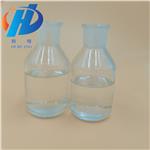Ethyl Acetoacetate: A Versatile Compound for Biofilm Inhibition and Organic Synthesis
May 16,2024
General Description
Ethyl acetoacetate has emerged as a promising compound for inhibiting bacterial biofilm formation, showing efficacy across various pathogens. It is cost-efficient and safe for human consumption, with low acute toxicity. Recent studies have highlighted its superior efficacy over acetoacetic acid in inhibiting biofilm formation. Furthermore, in organic synthesis, ethyl acetoacetate's tautomeric properties make it a crucial component in preparing various compounds, including pharmaceuticals. The incorporation of boron into ethyl acetoacetate has expanded its synthetic potential, offering opportunities for the synthesis of complex molecular scaffolds.

Figure 1. Ethyl acetoacetate
Applications as Novel Inhibitors of Bacterial Biofilm
Ethyl acetoacetate has emerged as a promising compound for inhibiting bacterial biofilm formation, offering potential applications in combating infections caused by various pathogens. Unlike its precursor, acetoacetic acid (AAA), which is both expensive and effective only at high concentrations, Ethyl acetoacetate presents a more cost-efficient alternative with enhanced efficacy. Ethyl acetoacetate, commonly known as the ethyl ester of AAA, is utilized as a flavoring ingredient in food products, indicating its safety for human consumption. Its toxicity profile, with an LD50 of 3.98 g/kg of body weight in rats, suggests a relatively low level of acute toxicity. In a recent study, researchers investigated the inhibitory effects of Ethyl acetoacetate on the planktonic growth and biofilm formation of several bacterial pathogens, including Yersinia enterocolitica, Cronobacter sakazakii, and Serratia marcescens. The results demonstrated significant reductions in both planktonic growth and biofilm biomass, particularly evident in Y. enterocolitica. At 25°C, Ethyl acetoacetate exhibited a concentration-dependent decrease in planktonic growth and biofilm biomass of Y. enterocolitica, with notable reductions observed at concentrations as low as 7.5 mg/ml. The inhibitory effect was consistent across various parameters, with IC50 values indicating effective inhibition of planktonic growth and biofilm formation. Similarly, at 37°C, Ethyl acetoacetate showed a concentration-dependent reduction in planktonic growth and biofilm biomass of Y. enterocolitica, with complete abolition of biofilm formation observed at higher concentrations. Interestingly, the mechanism of action at this temperature may involve a reduction in the energy content of bacterial cells within the biofilm, suggesting a multifaceted mode of action. Moreover, Ethyl acetoacetate demonstrated superior efficacy compared to AAA in inhibiting biofilm formation in C. sakazakii and S. marcescens, further highlighting its potential as a novel biofilm inhibitor across different bacterial species. In conclusion, the findings suggest that Ethyl acetoacetate holds promise as a novel inhibitor of bacterial biofilm formation, with implications for the development of antimicrobial strategies targeting biofilm-associated infections. Further research is warranted to elucidate its precise mechanism of action and assess its potential clinical applications. 1
Applications in Organic Synthesis
Ethyl acetoacetate, a molecule with keto/enol tautomeric properties, holds immense significance in organic synthesis and chemical education. Its versatility stems from its electrophilic and nucleophilic functionalities, making it a crucial component in the preparation of various compounds, including heterocycles, natural products, and pharmaceuticals like edaravone, teriflunomide, and eltrombopag. In recent studies, the incorporation of a boron moiety into ethyl acetoacetate has expanded its synthetic potential even further. By introducing boron handles at either the α- or β-positions of acetoacetate through homologation reactions with acyl-MIDA boronates and diazoacetates, researchers have generated borylated derivatives. The regiochemistry of this reaction is influenced by the steric bulk of the diazo species, with both alkyl and boron groups demonstrating the propensity to migrate. These borylated derivatives offer a range of opportunities for additional transformations. They can be modified into borylated pyrazolones and oximes, thus broadening the synthetic toolkit and enabling the synthesis of compounds not easily accessible through conventional methods. Furthermore, the regioselectivity of the reaction has been investigated experimentally and computationally, shedding light on the interplay between electronic and steric effects in controlling the tautomerization pattern of borylated acetoacetate. The versatility of these borylated derivatives extends to their potential conversion into heterocycles, oximes, and ketones, thereby offering ample opportunities for library expansion and enhancing the role of organoboron building blocks in automated synthesis. Overall, the introduction of boron functionality into ethyl acetoacetate represents a significant advancement in organic synthesis, providing chemists with novel tools for the construction of complex molecular scaffolds. 2
Reference
1. Horne SM, Schroeder M, Murphy J, Prüβ BM. Acetoacetate and ethyl acetoacetate as novel inhibitors of bacterial biofilm. Lett Appl Microbiol. 2018; 66(4): 329-339.
2. Trofimova A, White B, Diaz DB, et al. A Boron Scan of Ethyl Acetoacetate Leads to Versatile Building Blocks. Angew Chem Int Ed Engl. 2024; 63(15): e202319842.
- Related articles
- Related Qustion
Dibutyl phthalate, a common plasticizer, has significant antiandrogenic effects, impacting maternal health, fetal development, and reproductive outcomes in studies on pregnant rats.....
May 16,2024APIYes. Glyoxal fixation enhances immunohistochemical signals, and adjusting the glyoxal fixative to pH 4 or 5 is key for this effect.....
May 16,2024APIEthyl acetoacetate
141-97-9You may like
Ethyl acetoacetate manufacturers
- Ethyl acetoacetate
-

- $0.00 / 1G
- 2024-05-31
- CAS:141-97-9
- Min. Order: 1G
- Purity: 99%
- Supply Ability: 20
- Ethyl acetoacetate
-

- $0.00 / 190kg
- 2024-05-30
- CAS:141-97-9
- Min. Order: 190kg
- Purity: 98%
- Supply Ability: 10000
- Ethyl acetoacetate
-

- $3.00 / 25kg
- 2024-04-20
- CAS:141-97-9
- Min. Order: 1kg
- Purity: 99.92%
- Supply Ability: 50000tons




